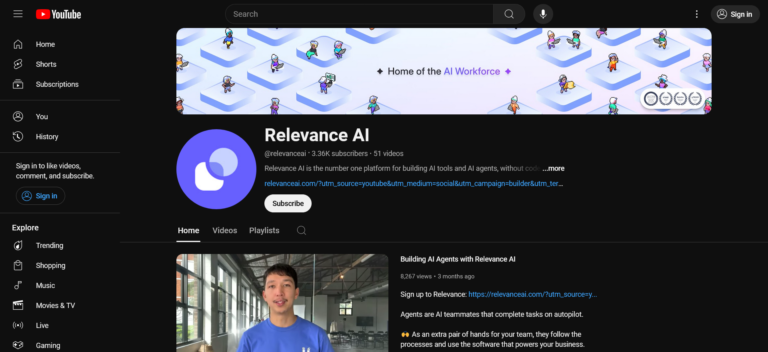The Challenge of Working with LLMs: Insights from Relevance AI
Relevance.ai
Absolutely incredible! Relevance.ai’s Agents are a true game-changer for any team looking to automate workflows and enhance productivity. These AI teammates handle tasks on autopilot, becoming an extra pair of…
Key Take-aways
- LLMs: The Good and Bad: Large Language Models (LLMs) can produce varied, expressive outputs but also introduce unpredictability. This can make AI pipelines unreliable, requiring a careful balance between flexibility and stability.
- Tools vs. Agents: AI tools excel at performing specialized tasks with consistent outputs, while AI agents handle decision-making, adapting to different scenarios by choosing and coordinating tools effectively.
- Effective Debugging Strategies: Debugging LLMs requires breaking complex tasks into smaller steps and using “Chain of Thought” prompts. Documented test cases provide clarity, confidence, and quicker troubleshooting.
LLMs offer both opportunities and challenges in AI development. In a recent presentation, Charlie, an AI engineer at Relevance AI, provided expert insights on how to work effectively with LLMs, when to use tools versus agents, and the best strategies for debugging. This article explores key takeaways and actionable strategies for AI professionals.
Success Stories: Using LLMs, Tools, and Agents Effectively
Charlie’s experience with AI development offers practical examples of how to leverage LLMs, tools, and agents:
- Leveraging AI Tools for Specialized Tasks: Tools are designed for specific, repeatable functions. When given the same input, a tool provides a consistent output, making it suitable for predictable tasks like data retrieval, search queries, or web scraping.
- Example: In a recent project, Charlie created specialized tools for Instagram scraping, LinkedIn searching, and Google searches. Each tool focused on one task, ensuring consistent and reliable results.
- Using AI Agents for Complex Decision-Making: AI agents excel at handling dynamic tasks by deciding which tools to use, when to use them, and how to manage outputs. Agents act as orchestrators, making decisions based on varying inputs and tasks.
- Example: Charlie developed a researching agent that integrates multiple tools. The agent could find information across platforms like Instagram, Google, and Facebook, adapting its approach based on the task requirements.
What Are LLMs, Tools, and Agents? Key Features of Each
Understanding when to use LLMs, tools, or agents is crucial for effective AI automation. Here’s a breakdown of their core characteristics:
- LLMs (Large Language Models): These models can generate varied and expressive outputs, making them powerful but unpredictable. They require structured prompts and debugging strategies to ensure reliable performance.
- Examples: Text generation, creative content production, and summarization tasks that benefit from LLMs’ broad language capabilities.
- AI Tools: Tools are specialized, performing specific tasks with consistent outputs. They are ideal for tasks that require deterministic workflows, where consistent results are necessary.
- Examples: Web scraping, keyword extraction, and repetitive data processing tasks.
- AI Agents: Agents act as decision-makers, capable of handling complex tasks by integrating and coordinating multiple tools. They adapt to varying inputs and decide on the best course of action in real-time.
- Examples: Research agents, customer support automation, and dynamic data analysis workflows.
Building AI Tools and Agents: Best Practices from Relevance AI
Charlie shared valuable strategies for building and debugging AI tools and agents at Relevance AI:
- Using AI Tools for Predictable Tasks:
- Specialized Functions: AI tools should be designed for specific tasks, ensuring consistent outputs. For example, Charlie’s Google search tool reliably handles search queries, providing consistent results.
- Modular Design: Tools should be modular, focusing on one task at a time. This makes debugging easier and ensures reliability.
- Example from Relevance AI: Relevance AI’s content generation tools are structured to handle specific content tasks, like generating blog introductions, bodies, and conclusions separately.
- Using AI Agents for Dynamic Tasks:
- Decision-Making Capabilities: AI agents are suited for tasks that require adaptability, decision-making, and coordination between tools. For instance, Charlie’s researching agent integrates multiple tools and decides how to use them based on the task requirements.
- Broad Functionality: Agents provide a flexible interface for integrating various tools, making them ideal for handling complex workflows that require real-time adjustments.
- Example from Relevance AI: Relevance AI’s multi-tool agents manage dynamic workflows like customer research, integrating web scraping, social media analysis, and more.
Debugging Strategies for LLMs, Tools, and Agents
Debugging LLMs is one of the most challenging aspects of AI development. Charlie shared some of his top strategies:
- Break Down Complex Tasks: Don’t overload LLMs with lengthy prompts. Instead, break complex tasks into smaller steps, allowing the model to process each step accurately.
- Example: Instead of asking an LLM to generate a complete article in one prompt, use separate prompts for each section—introduction, body, and conclusion.
- Use Chain of Thought Prompting: Encourage the LLM to think through tasks step-by-step. This improves the quality of the output and offers insights into the LLM’s decision-making process, making it easier to identify where issues might arise.
- Example: When troubleshooting an LLM-generated summary, examine the step-by-step reasoning to understand potential errors and refine the prompt.
- Implement a Strong Testing Suite: Build a testing suite with clear test cases for each tool and agent. Document expected inputs, outputs, and actions, allowing for confident changes and quick identification of errors.
- Example: For the researching agent, Charlie created test cases that included expected actions like searching Instagram, Google, and Facebook, ensuring consistent performance.
Top Use Cases for LLMs, Tools, and Agents
Deciding between LLMs, tools, and agents depends on the task’s complexity and predictability. Here are some top use cases:
- LLMs:
- Creative Content Generation: Use LLMs for tasks that require diverse and expressive language, such as article writing, social media posts, or product descriptions.
- Text Summarization: LLMs excel at summarizing long texts, making them ideal for research, content curation, or documentation.
- AI Tools:
- Data Retrieval: Tools are perfect for web scraping, structured data extraction, and keyword research.
- Routine Automation: Use tools for repetitive tasks that follow consistent steps, like form filling or simple data processing.
- AI Agents:
- Dynamic Problem Solving: Agents can manage tasks with varying inputs, such as customer support automation or market research.
- Integrated Workflows: AI agents act as orchestrators, coordinating multiple tools to handle complex workflows effectively.
Analyzing the Benefits of AI Tools and Agents
While LLMs, tools, and agents offer unique benefits, they also have distinct challenges:
- LLMs: Their flexibility can be a double-edged sword, introducing unpredictability. Debugging requires breaking down tasks and using structured prompts.
- AI Tools: They provide consistent outputs but are limited to specific tasks. Modular design is essential for building effective tools.
- AI Agents: Agents offer adaptability and integration, but they require effective coordination and decision-making capabilities to handle complex workflows.
Monetization Methods for AI Tools and Agents
Businesses and developers can monetize AI tools and agents through several strategies:
- Subscription-Based SaaS: Offer AI tools and agents as part of a subscription service, providing regular updates and support.
- Custom AI Solutions: Provide tailored AI tools or agents for specific industries, offering consulting services to help businesses implement AI solutions.
- Educational Courses: Develop courses focused on building, debugging, and deploying AI tools and agents, using platforms like Relevance AI as a base.
Is LLM-Based Automation Right for You?
LLMs, tools, and agents provide a diverse range of automation possibilities. While LLMs are powerful for creative content and dynamic text generation, AI tools offer reliable, specialized task automation. AI agents, meanwhile, provide the flexibility needed for complex, integrated workflows.
If you’re looking to automate predictable tasks, start with AI tools. For dynamic, decision-based tasks, explore the capabilities of AI agents. Relevance AI’s expertise in building, testing, and refining LLMs, tools, and agents offers a comprehensive approach to AI automation.
Ready to explore LLMs, tools, and agents? Discover how Relevance AI can help you create reliable, scalable automation solutions today.

